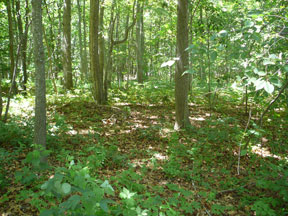 What is it?
What is it?
Coastal forests are found along the coast and are subject to a maritime climate (generally cooler summers and milder winters than further inland). These forests do not receive daily salt spray (as a true maritime forest may), but can be subject to wind and salt spray during storm events.
Vegetation
Oak trees, particularly black, white, chestnut and scarlet, are often the dominant trees of these forests. Other trees that may be intermixed with the oaks include black cherry, sassafras, red maple, beech, tupelo, white pine and pitch pine. Shrubs may include low bush blueberries, black huckleberry and viburnums. Vines are very characteristic of coastal forest edges and openings including Virginia creeper, poison ivy, grape and greenbriers.
Why They’re Important
Due to intense agricultural and development pressures, Connecticut has very little forest left within the coastal zone. What is left is often heavily browsed by deer and colonized by invasive plant species. Raising awareness of where and what these forests are will aid in protection and restoration efforts.
Climate Change Impacts
Climate Change – Similar to grasslands and shrublands, changes in air temperature, precipitation patterns, and storms may impact Connecticut forests and woodlands. Along the coast, the frequency and intensity of tropical cyclones (tropical storms and hurricanes) may impact coastal forests through wind damage and salt spray. Similarly changes in extra tropical cyclones (nor’easters, typical low pressure systems), may also damage trees with high winds, snow and ice.
Changes in length of the growing season and average annual temperatures may lead to changes in species composition of forests. Species with a more southerly range may move northward while species that are on the southern limits of their range in Connecticut may decrease in population numbers. Other species that have limited ability to adapt to changes may also decrease in numbers.
Invasive species pose a serious threat to Connecticut’s forests. Spongy moths, hemlock woolly adelgid and emerald ash borer are just a few of the invasive insects that have already severely impacted areas. Warming average air temperatures, less snowpack and other factors may lead to new invasions of animal pests as well as new invasive plant species colonizing forests and woodlands.
Further information on climate change impacts to Connecticut’s forests can be found here.
Details
For more detailed information download the Long Island Sound Study Coastal Forest Chapter.
For Citation Purposes: Connecticut Sea Grant & University of Connecticut’s Center for Land Use Education and Research. (October 20, 2016). Forests & Woodlands. https://climate.uconn.edu/habitats-resources/coastal/forests